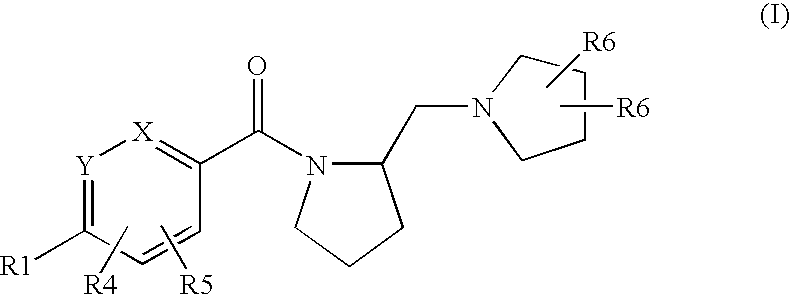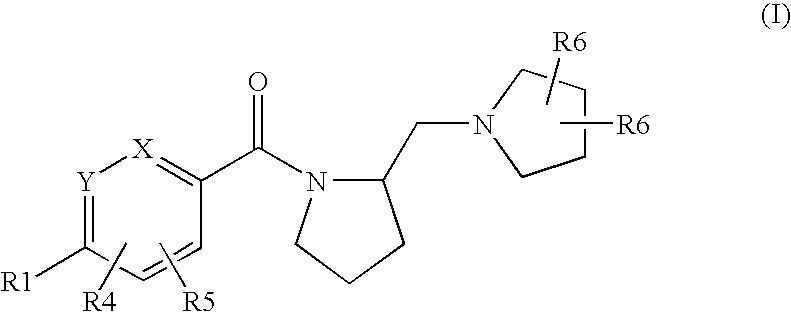Histamine h3 receptor agents, preparation and therapeutic uses
a technology of histamine and receptor, applied in the field of new substituted arylmethanonepyrrolidinylmethylpyrrolidinyl compounds, can solve the problems of poor blood-brain barrier penetration of imidazole-containing compounds, hepatic and ocular toxicities, and unsatisfactory side effects, and achieve selective and high affinity binding
- Summary
- Abstract
- Description
- Claims
- Application Information
AI Technical Summary
Benefits of technology
Problems solved by technology
Method used
Image
Examples
example 1
(S)-(4-Pentyl-phenyl)-(2-pyrrolidin-1-ylmethyl-pyrrolidin-1-yl)-methanone
[0144]
[0145]Procedure A: 4-Pentylbenzoic acid (62 mg, 0.32 mmol) and PS-carbodiimide (mmol / g=1.32, 484 mg, 0.64 mmol) are combined in 5.0 ml of 5% DMF in Dichloromethane and mixed well in a vial. (S)(+)-1-(2-Pyrrolidinylmethyl)pyrrolidine (50 mg) is added to this mixture and the vial is capped with a Teflon cap. The vial is shaken at room temperature overnight. The mixture is filtered and the resin is washed with dichloromethane. The filtrate is concentrated under N2 gas and applied to silica-gel column chromatography (CH2Cl2 followed by CH2Cl2: 2M NH3 in MeOH=45:1) to give the product. Observed mass: 329 (M+1).
example 2
(S)-(4-Methylsulfanyl-phenyl)-(2-pyrrolidin-1-ylmethyl-pyrrolidin-1-yl)-methanone
[0146]
[0147](S)-(4-Methylsulfanyl-phenyl)-(2-pyrrolidin-1-ylmethyl-pyrrolidin-1-yl)-methanone is prepared from 4-(methylthio)benzoic acid in a manner substantially similar Procedure A. Observed mass 305.
example 3
(S)-[4-(4-Methyl-cyclohexylsulfanyl)-phenyl]-(2-pyrrolidin-1-ylmethyl-pyrrolidin-1-yl)-methanone
[0148]
[0149](S)-[4-(4-Methyl-cyclohexylsulfanyl)-phenyl]-(2-pyrrolidin-1-ylmethyl-pyrrolidin-1-yl)-methanone is prepared from 4-(4-methyl-cyclohexylsulfanyl)-benzoic acid in a manner substantially similar Procedure A. Observed mass 387.
PUM
| Property | Measurement | Unit |
|---|---|---|
| Fraction | aaaaa | aaaaa |
Abstract
Description
Claims
Application Information
 Login to View More
Login to View More - R&D
- Intellectual Property
- Life Sciences
- Materials
- Tech Scout
- Unparalleled Data Quality
- Higher Quality Content
- 60% Fewer Hallucinations
Browse by: Latest US Patents, China's latest patents, Technical Efficacy Thesaurus, Application Domain, Technology Topic, Popular Technical Reports.
© 2025 PatSnap. All rights reserved.Legal|Privacy policy|Modern Slavery Act Transparency Statement|Sitemap|About US| Contact US: help@patsnap.com



